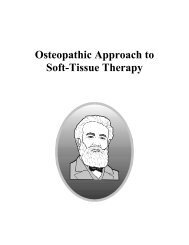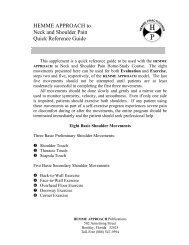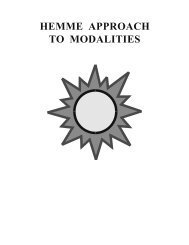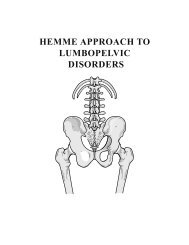HEMME APPROACH TO SOFT-TISSUE THERAPY
HEMME APPROACH TO SOFT-TISSUE THERAPY
HEMME APPROACH TO SOFT-TISSUE THERAPY
You also want an ePaper? Increase the reach of your titles
YUMPU automatically turns print PDFs into web optimized ePapers that Google loves.
The end-feel for most joints is either hard like elbow extension or soft like<br />
elbow flexion. End-feels that are soft when they should be hard or hard when<br />
they should be soft indicate joint dysfunction. If the problem appears to be<br />
joint dysfunction, palpate the joint for signs of heat, swelling, or pain. Normal<br />
joints are never swollen and normal ligaments are not painful when palpated.<br />
The next possibility to investigate is spasm or contracture. Spasms can<br />
result from calcium deprivation (carpopedal spasm), sewing or writing<br />
(occupational spasm), spasmodic contraction of muscles (intentional spasm),<br />
disease (myopathic spasm), or trauma (charley horse). Contractures, on the<br />
other hand, are caused by tissue fibrosis (ischemic contracture), sleeping in or<br />
maintaining a position that allows the muscles to shorten (functional<br />
contracture), or the effects of heat or chemicals (physiological contracture).<br />
Both spasm and contracture restrict joint movement by increasing resistance to<br />
passive stretch.<br />
The initial end-feel for spasm or contracture is more like stretching a<br />
spring than either hard or soft: the greater the stretch, the greater the<br />
resistance. If properly applied, slow and steady tension will cause a decrease<br />
in resistance. The key points are (1) apply moderate force directly against the<br />
resistance and (2) use slow and steady pressure. Unlike pathologic joints that<br />
normally become more painful with stretching, muscles in a state of spasm or<br />
contracture often become less painful as tissues approach their normal length.<br />
(3) Active-Assisted Range-of-Motion Testing<br />
If the patient's passive ROM is normal, the next step is active-assisted<br />
range-of-motion testing. If a full range of motion is possible with assistance<br />
from the examiner, the implication is muscular weakness. Having the patient<br />
move as far as possible in one direction and then using manual assistance to<br />
complete the range of motion will help to identify which muscles or muscle<br />
groups are weak. The normal approach at this point is using facilitation<br />
techniques or therapeutic exercise to strengthen weak muscles. Facilitation<br />
techniques such as methods for activating spindle cells and repeated<br />
contraction are part of neuromuscular therapy. Therapeutic exercises to<br />
strengthen weak muscles are called progressive resistance exercises.<br />
32<br />
<strong>HEMME</strong> Approach to Soft-Tissue Therapy









